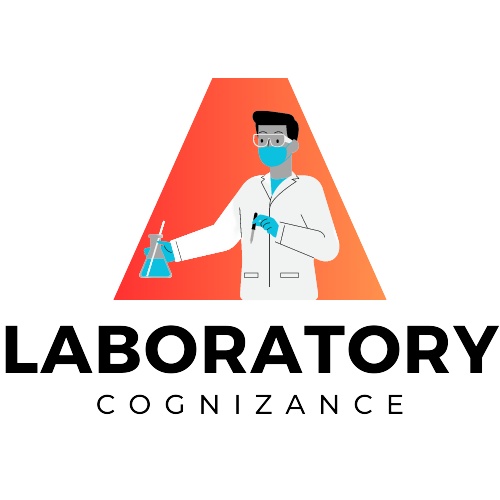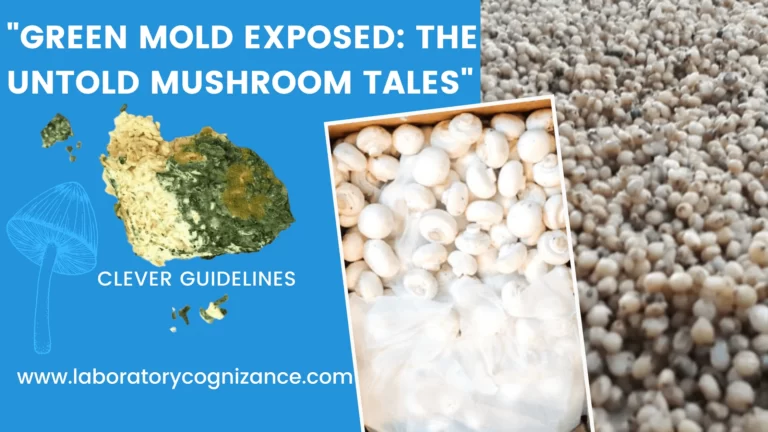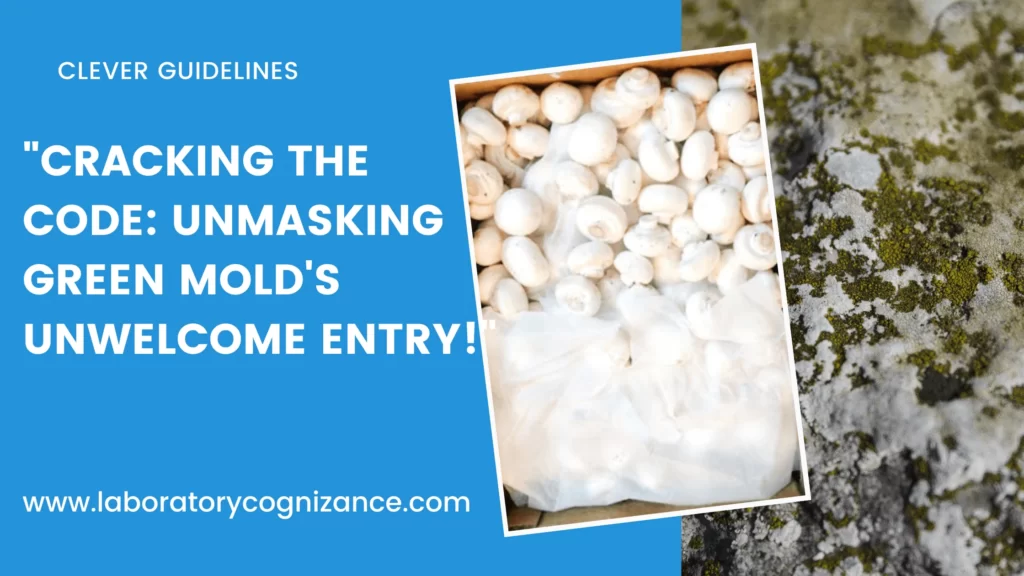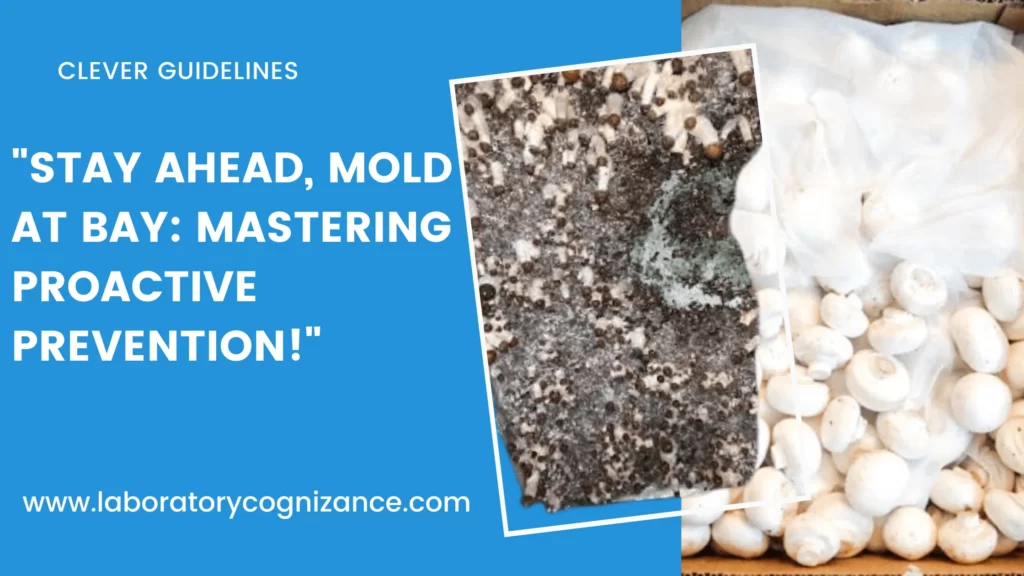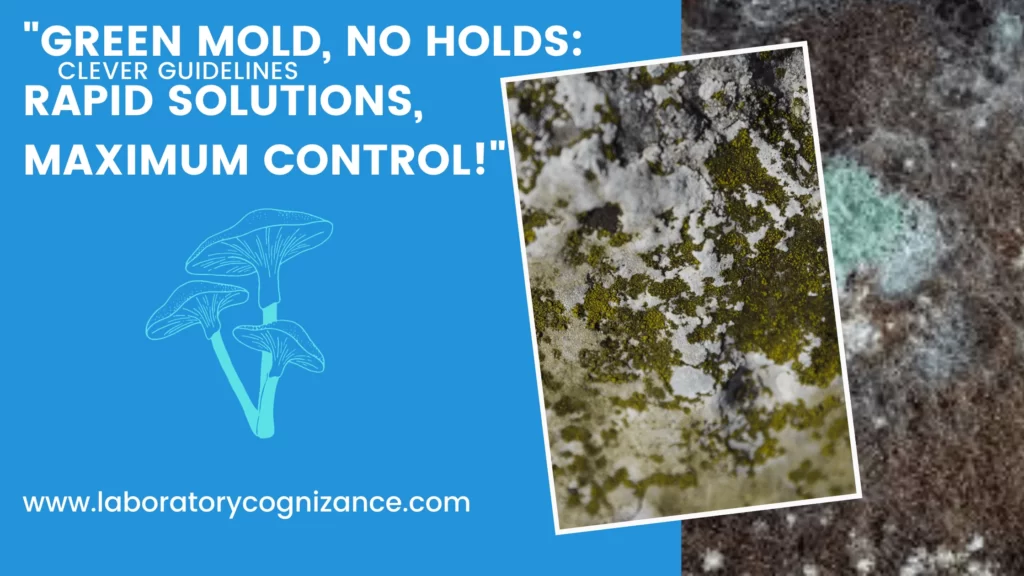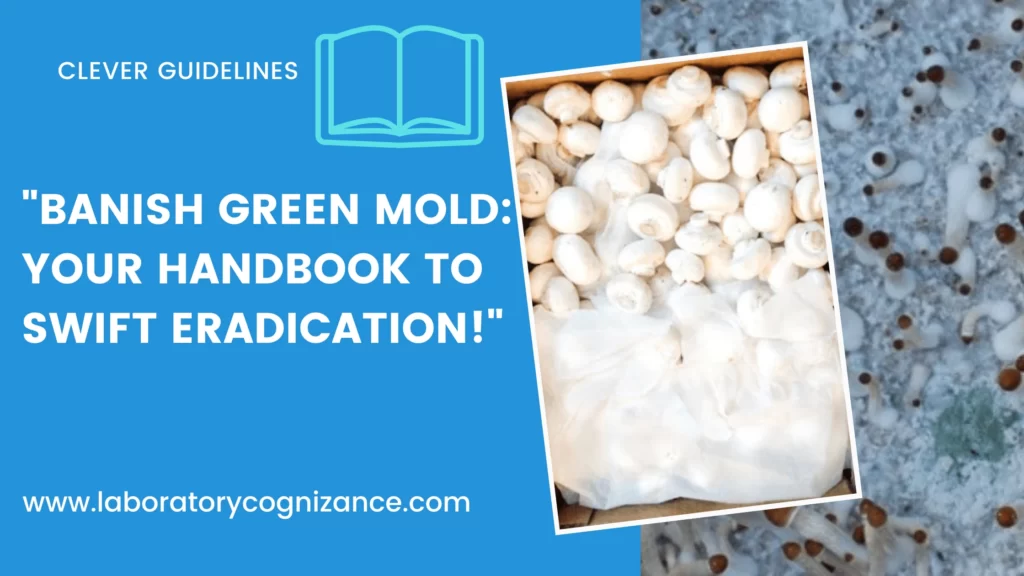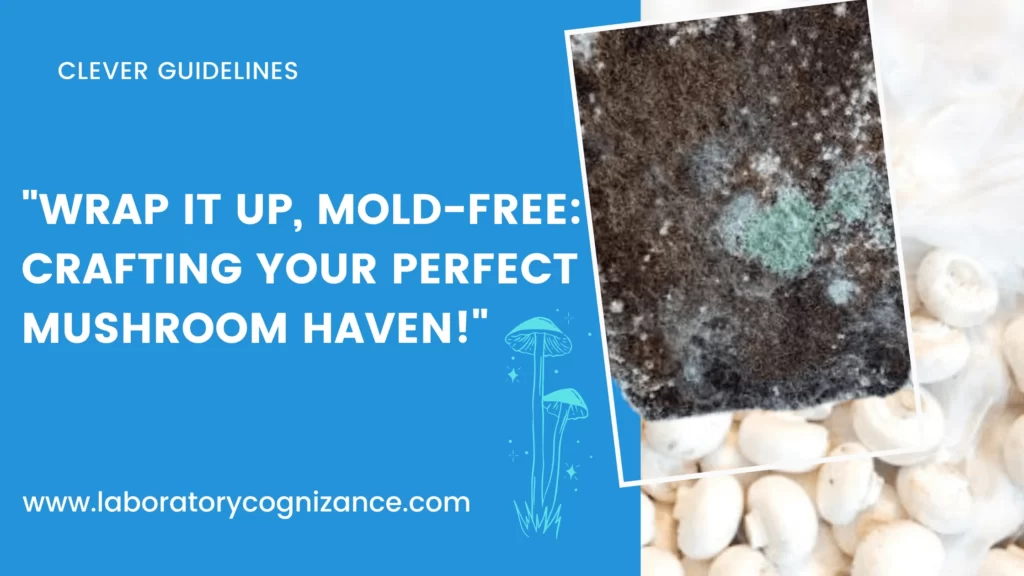Knowing your opponent is the initial step in any fight. The distinctively greenish-colored green mold on Mushrooms is a common product of the Trichoderma species.
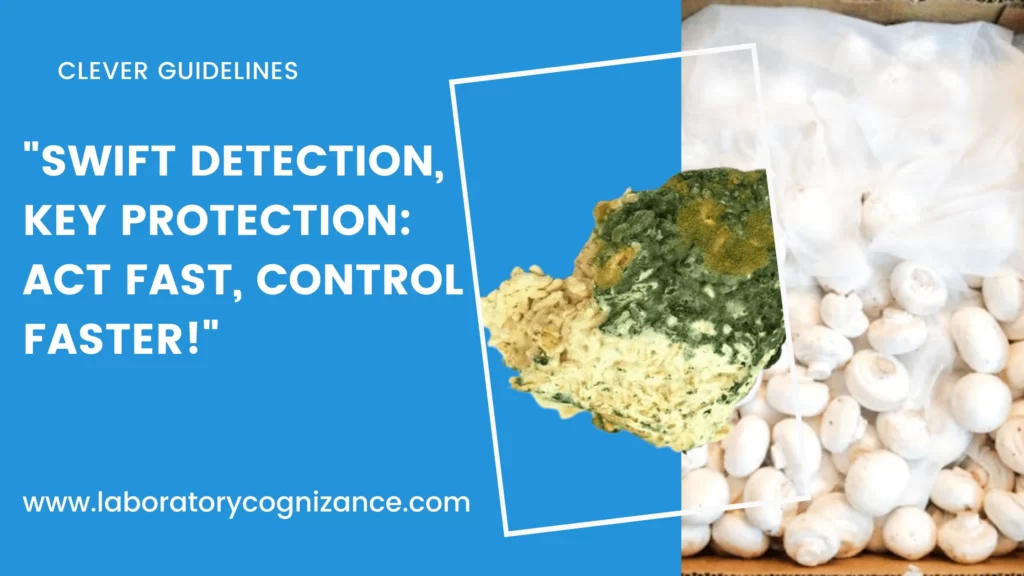
Identifying it promptly is crucial for implementing control measures
Effective control measures must be implemented with timely identification. Rapid detection enables accurate solutions, effectively avoiding possible dangers, whether handling environmental or health problems.
Tips:
- Be attentive to stunted or deformed mushroom growth, as these can be indicators of green mold presence.
- Monitor for changes in color, texture, or aroma, as these can signal contamination.
- Install effective ventilation systems to promote a well-circulated & fresh air environment in your cultivation space.
- Educate your team on contamination prevention & best practices in mushroom cultivation.
- Adhere to stringent sterilization practices to minimize or reduce the risk of introducing mold spores during cultivation.
- Stay informed about the latest cultivation techniques & disease prevention methods to foster a culture of continuous improvement.
- Institute a quarantine protocol for contaminated mushrooms or substrates to prevent the further spread of green mold.
- Rotate mushroom strains regularly to reduce susceptibility to specific molds & diseases.
- Engage with cultivation forums & experienced growers to share insights & strategies for effective mold prevention.
- Familiarize yourself with the specific traits of green mold, including its color, texture, & growth patterns.
- Consider the use of natural fungicides or biological control agents as alternatives to manage green mold growth.
- Keep meticulous records of cultivation practices, aiding in the identification of patterns or potential contamination sources.
- Regularly inspect your mushroom cultivation area for any indications of green mold.
- Regularly test the environmental conditions to ensure optimal growing conditions & early identification of potential issues.
- Regularly assess & ensure the quality of water used in the cultivation process to prevent the introduction of molds.
- Minimize the risk of contamination during handling by investing in quality personal protective equipment or gear (PPE).
- Remove affected mushrooms or substrates promptly at the first signs of green mold.
- Monitor & control environmental factors such as temperature & humidity to discourage mold growth.
- Choose high-quality, sterilized substrates to lower the likelihood of mold contamination.
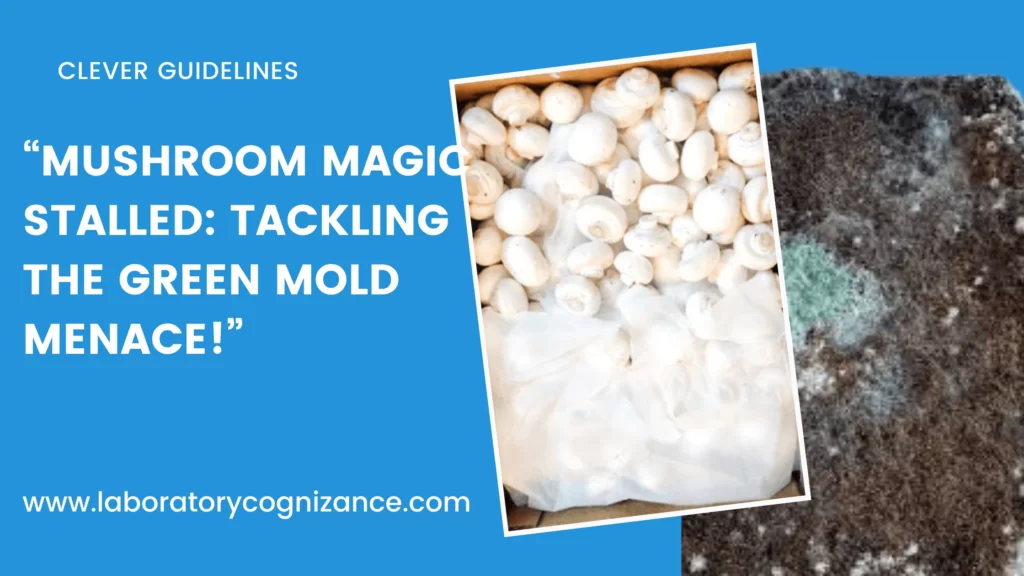
The Impact of Green Mold on Mushroom Growth
To combat green mold effectively, it’s essential to grasp the impact it has on mushroom growth. This knowledge will guide your prevention & treatment strategies.
Tips:
- Swiftly isolate sections displaying green mold to prevent its spread to healthy mushroom growth areas.
- Modify the environmental parameters, including temperature & humidity, to maintain the optimal range for mushroom growth while discouraging conditions favorable to green mold.
- Improve the ventilation within the cultivation space to minimize the likelihood of mold spores settling on the substrate & mushrooms.
- Incorporate organic antifungal agents or beneficial microorganisms that can naturally suppress green mold growth without causing harm to the mushrooms.
- Implement & uphold rigorous cleanliness standards during handling, ensuring thorough sanitization of tools & equipment to prevent cross-contamination.
- Change the mushroom strains being cultivated regularly to minimize the risk of green mold adapting & affecting specific varieties.
- Adjust the composition of the substrate to create an environment less conducive to green mold, thereby deterring its colonization.
- Conduct regular visual inspections to promptly identify any signs of green mold, enabling early intervention.
- Provide comprehensive training to cultivation personnel on recognizing, preventing, & treating green mold, enhancing overall awareness & responsiveness.
- Explore the introduction of organisms that prey on green mold, acting as natural biological controls to limit its growth.
- Establish strict biosecurity measures to minimize the risk of external contamination, thereby reducing the introduction of green mold spores.
- Modify watering schedules & methods to maintain optimal moisture levels for mushrooms while discouraging mold growth.
- Evaluate the effectiveness of ultraviolet-C (UV-C) light treatments in controlling mold within the cultivation area.
- Combine various prevention & treatment methods to create a multi-faceted defense against green mold.
- Quickly dispose of contaminated materials, ensuring responsible removal to prevent further mold spread.
- Keep meticulous records of cultivation practices to enable a retrospective analysis, identifying patterns or potential sources of green mold.
- Seek advice & collaboration with experienced growers or mycologists who can offer insights & tailored solutions for effective green mold management.
- Stay proactive by continuously updating prevention strategies based on evolving knowledge & emerging technologies.
- Introduce physical barriers, such as air filtration systems or sealed cultivation chambers, to prevent the entry of mold spores.
- Stress the significance of swift action at the first signs of green mold, highlighting the importance of early intervention in controlling its impact on mushroom growth.
Understanding the Causes: What Invites Green Mold?
Being aware of the environmental factors that encourage the formation of green mold is just as important as taking proactive measures. Eliminating these problems as fast as they appear can reduces significantly the chance of contamination.
Tips:
- Maintain consistent temperatures within the ideal range for mushroom growth to discourage conditions conducive to green mold.
- Regularly monitor & manage humidity levels, ensuring they stay within optimal parameters to mitigate the likelihood of green mold development.
- Improve air circulation to prevent stagnation, minimizing the environment favorable for the growth of mold spores.
- Implement rigorous cleanliness standards in the cultivation area to eradicate potential sources of green mold.
- Swiftly eliminate any visible mold spores or contaminated materials to curtail their spread.
- Verify the quality of the substrate, as subpar materials can contribute to the emergence of green mold.
- Isolate & address contaminated sections promptly to prevent the spread of green mold to healthy areas.
- Adjust watering schedules & methods to maintain the optimal moisture balance, minimizing the risk of mold growth.
- Enforce stringent biosecurity measures to minimize the introduction of external contaminants that may foster green mold.
- Provide comprehensive education to cultivation personnel about the environmental factors favoring green mold, cultivating awareness and proactive measures.
- Conduct routine evaluations of environmental conditions to detect & address potential issues proactively.
- Tailor substrate composition to create an environment less inviting to green mold.
- Select mushroom strains known for their resistance to common molds, thereby reducing vulnerability to green mold.
- Consistently inspect the cultivation area for indications of environmental conditions that might encourage green mold formation.
- Integrate natural ventilation methods, like opening windows or using fans, to minimize humidity & prevent stagnation.
- Seek guidance from experienced growers or mycologists for insights into effective environmental management.
- Maintain meticulous records of environmental conditions & analyze patterns to identify and address recurring issues.
- Investigate the potential use of ultraviolet-C (UV-C) light treatments as a preventive measure against mold spores.
- Develop and emphasize protocols for early intervention at the first signs of environmental conditions conducive to green mold.
- Stay informed about the latest research & advancements in environmental controls, fostering a proactive & evolving approach to mold prevention.
Prevention Techniques: A Proactive Approach
Proactively combating green mold entails putting preventative measures in place from the outset of your mushroom-growing efforts.
Tips:
- Make sure your cultivation space is super clean to avoid any unwanted guests, especially green mold spores.
- Everyone who steps into the growing space needs to wash up properly to avoid spreading potential contaminants.
- Pick high-quality substrates that have a reputation for standing up to mold, so you don’t invite green mold trouble.
- Keep an eye on the temperature levels – mushrooms like it cozy, but you don’t want it too comfy for green mold.
- Install a system that keeps humidity in check; too much moisture can be an open invitation for green mold.
- Use air filters to ensure the air coming in is pure and free from sneaky mold spores.
- The moment you spot any mold or suspect contaminated materials, get rid of them pronto to prevent a spreading disaster.
- Make it a habit to visually inspect your setup regularly. Catching green mold early is like catching it napping.
- Educate your crew on how to spot and deal with green mold. A well-informed team is your best defense.
- Keep the molds guessing by changing up your mushroom strains regularly.
- If you find green mold, set up protocols to keep it isolated & away from the healthy mushroom spots.
- Use nifty tech tools like sensors to keep a constant eye on the environment, catching any irregularities in the act.
- Consider using helpful microorganisms or natural predators to keep green mold in check without resorting to harsh chemicals.
- Show some love to your substrate regularly, making sure it’s in top-notch condition to resist any mold threats.
- Make sure your team knows the ins & outs of what makes green mold tick – knowledge is power.
- Experiment with using UV-C light to fend off mold spores. It’s like a light barrier for your mushrooms.
- Fine-tune your watering routine, keeping things moist for the mushrooms but not too damp for mold to party.
- Make smart choices based on the data you collect. If something’s off, adjust your game plan accordingly.
- Give your cultivation tools some regular attention – clean and well-maintained tools are less likely to introduce trouble.
- Encourage your team to always look for ways to do things better. A team that grows together stays mold-free together.
Controlling Green Mold: Swift and Efficient Measures
Swift action is essential when green mold is detected. A contaminated harvest and extensive contamination can result from postponing treatment.
Tips:
- When you see any hint of green mold, separate that area fast to stop it from spreading.
- Don’t wait – toss out any harvest that’s showing signs of contamination to keep it from spreading.
- Chuck out contaminated stuff responsibly, far away from your growing area to keep mold risks at bay.
- If you’re suspicious about something carrying green mold, lock it down with strict quarantine measures.
- Boost ventilation in the affected areas to scatter those mold spores & lower their concentration.
- Soon as you spot green mold, throw some organic antifungal stuff on it to slow it down.
- Use hydrogen peroxide on the areas with mold to kick its growth in the bud.
- Adjust the temperature a bit lower to make things less comfy for the mold to spread.
- Lower humidity levels quickly – mold loves moisture, so let’s take that away.
- Scrub and sanitize every nook and cranny that might have touched the mold – be thorough.
- Introduce some helpful bugs or organisms that love to eat up green mold – let nature fight back.
- Literally! Use UV-C light where the mold is – it’s like a spotlight that keeps mold at bay.
- Be cautious but use approved fungicides for a quick and effective hit against green mold.
- Don’t hesitate to chat with experienced growers or experts to figure out a personalized plan to tackle the mold.
- Make sure everyone on the team knows what to do when they see green mold – a quick response is key.
- Use what you’ve learned from previous mold situations to get better at handling it in the future.
- Have a kit with all the tools and antifungal stuff ready to go in case you spot mold in a hurry.
- Amp up your watch over the growing area – catch any green mold making a comeback right away.
- Make sure everyone on the team knows how to communicate if there’s a mold outbreak – a well-coordinated team is a powerful team.
- After every incident, sit down & figure out what could be done better next time – it’s how we get smarter at stopping green mold.
Green Mold Treatment: A Detailed Handbook
Having a thorough treatment plan is essential in cases where prevention is insufficient. Recognize the procedures needed to treat green mold in order to ensure a good recovery.
Tips:
- Quickly identify the presence of green mold to initiate treatment without delay.
- Isolate sections with green mold to prevent further spread & contamination.
- Immediately remove any contaminated harvest to prevent additional spore release.
- Properly dispose of contaminated materials away from the cultivation area to minimize risks.
- Implement a strict quarantine protocol for suspected items or substrates to contain the mold.
- Improve ventilation to disperse mold spores & reduce their concentration.
- Apply organic antifungal agents to hinder the growth and spread of green mold.
- Use hydrogen peroxide for targeted spot treatment on affected substrates or surfaces.
- Temporarily adjust the temperature to the lower end of the optimal range to slow down mold growth.
- Decrease humidity levels to create an environment less favorable for green mold.
- Conduct thorough cleaning and sanitation of all surfaces and tools that may have come into contact with the mold.
- Introduce beneficial microorganisms or natural predators to control and limit the spread of green mold.
- Apply targeted exposure to ultraviolet-C (UV-C) light in affected areas, known for its effectiveness in mold control.
- Use approved fungicides cautiously as a rapid and efficient treatment against green mold, following recommended guidelines.
- Seek advice and collaborate with experienced growers or mycologists for tailored strategies in green mold treatment.
- Reinforce training for cultivation personnel on treatment protocols for green mold incidents.
- Utilize data from previous incidents to refine and optimize treatment strategies for future occurrences.
- Prepare kits containing necessary tools and antifungal agents for immediate action upon detecting green mold.
- Increase the frequency and thoroughness of surveillance in the treated areas to monitor recovery progress.
- Conduct a comprehensive analysis after treatment, identifying areas for improvement in the treatment plan & recovery process.
Conclusion: A Mold-Free Mushroom Cultivation Experience
In conclusion, the key to a mold-free mushroom farming experience is a mix of alertness, preventative measures, and quick response. By using these techniques in addition to the advice given, you’ll be prepared to deal with the problems caused by green mold & have a bountiful crop.
Recall that the key to long-term success in managing & preventing green mold on mushrooms is consistency in the application of these measures. Happy cultivating!
Faqs
Q: How does green mold impact mushroom growth?
A: Green mold can hinder mushroom growth, causing deformities and leading to a contaminated harvest.
Q: What sets Trichoderma green mold apart?
A: Trichoderma green mold is distinctly green and commonly found in mushroom cultivation.
Q: Why is early identification vital for green mold control?
A: Early detection allows prompt implementation of control measures, preventing further contamination.
Q: How can one develop an eye for recognizing green mold on substrates?
A: Regularly inspecting the cultivation area aids in recognizing the unique appearance of green mold.
Q: What signs suggest the presence of green mold in mushroom cultivation?
A: Indicators include stunted or deformed mushroom growth and alterations in color, texture, or aroma.
Q: Which environmental factors promote green mold formation?
A: Green mold thrives in environments where moisture accumulates and substrate moisture levels are off.
Q: Why is moisture’s buildup problematic, & how can it be prevented?
A: Mold grows when there is an accumulation of moisture; keeping adequate ventilation is one way to prevent this.
Q: How does a top-tier air filtering system deter mold spores?
A: It reduces the entry of mold spores, contributing to a cleaner cultivation environment.
Q: What proactive steps effectively combat green mold?
A: Prioritize cleanliness and invest in a high-quality air filtering system.
Q: What immediate actions are recommended upon detecting green mold?
A: Isolate affected locations promptly to prevent the spread of contamination.
Q: Which fungicides are advisable for treating green mold?
A: Use reputable fungicides, adhering to recommended application methods and dosages.
Q: Why is isolating affected locations crucial in contamination control?
A: It helps contain contamination spread, minimizing the impact on the entire cultivation area.
Q: How can a thorough fungicide application on affected areas be ensured?
A: Adhere to the manufacturer’s recommendations for application, covering all affected regions.
Q: What steps comprise a detailed treatment plan for green mold?
A: Remove contaminated mushrooms and substrate; then, apply the chosen fungicide thoroughly.
Q: Why is consistency vital for sustained success in managing green mold?
A: Consistently applying preventive measures ensures continual protection against green mold contamination.
